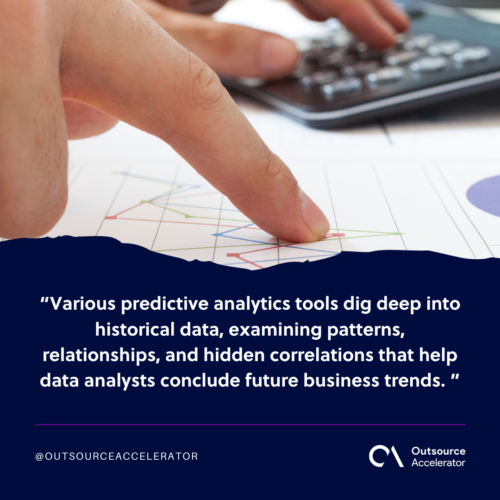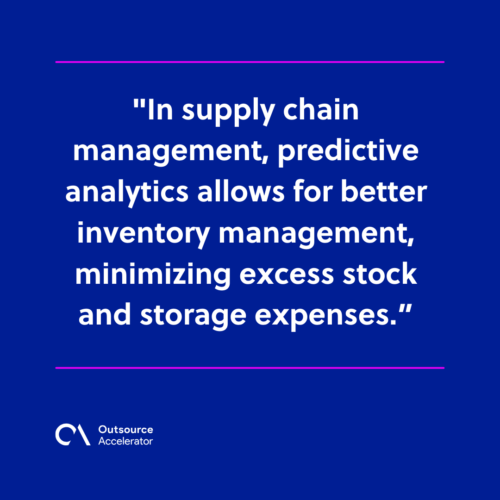10 predictive analytics tools to help your business succeed

List of 10 best predictive analytics tools
- SAS Cloud Analytics
- Amazon QuickSight
- Amazon Forecast
- Alteryx
- Tableau
- Adobe Analytics
- Software AG TrendMiner
- Qlik Sense
- Improvado
- Domo
Accurate trend forecasting empowers businesses to make informed and proactive decisions.
By anticipating shifts in consumer preferences, market trends, and economic conditions, companies can adjust their strategies, product offerings, and resource allocation accordingly.
This minimizes risks and maximizes opportunities.
In line with this, predictive analytics tool have emerged to enable organizations to predict future trends, anticipate customer behavior, and optimize operations.
This article explores the top predictive analytics tool, guiding you through what they are, what they offer, how to choose the right tool, and when to leverage it.
What is predictive analytics?
Predictive analytics is a sophisticated field of data science that has gained immense prominence in recent years due to its ability to unlock valuable insights into the future.
It extracts meaningful information from vast pools of historical and real-time data.
This information is leveraged with remarkable accuracy to anticipate what might happen next.
Data scientists can use predictive analytics to turn data into actionable knowledge.
It deploys an arsenal of statistical techniques and cutting-edge machine learning algorithms.
Various predictive analytics tools dig deep into historical data, examining patterns, relationships, and hidden correlations that help data analysts conclude future business trends.

Predictive analytics tools find their application in many scenarios across various industries.
In sales and marketing, predictive analytics software enables businesses to do the following:
Forecast customer demand
Optimize pricing strategies
Tailor marketing campaigns effectively
Additionally, organizations can make data-driven decisions to maximize revenue and customer engagement by analyzing historical sales data and consumer behavior.
Predictive analytics tools are also critical in assessing risk and making investment decisions in finance.
They aid in predicting stock market trends, identifying fraudulent transactions, and assessing credit risk.
Another example is in healthcare use. By analyzing patient data and trends, healthcare providers can optimize staffing, allocate resources efficiently, and enhance patient care quality.
Manufacturing and supply chain management also rely on predictive analytics to do the following:
Predictive equipment maintenance needs
Optimize production schedules
Manage inventory efficiently
Predictive maintenance, for example, helps prevent costly unplanned downtime by predicting when machinery might fail based on usage patterns and wear-and-tear indicators.
Lastly, predictive analytics tools can benefit human resources. This innovation can help identify high-potential employees, predict workforce demand, and improve talent acquisition strategies.
These tools assist HR professionals in making data-driven decisions about talent management, succession planning, and recruitment.
Key benefits of predictive analytics tools
Predictive analytics tools offer many advantages to businesses across various industries.
Here are the four key benefits of using predictive analytics platforms:
Enhanced decision-making
Predictive analytics tools empower organizations to make data-driven decisions by providing insights into future trends and outcomes.
Instead of relying solely on intuition or past experiences, decision-makers can access accurate predictions based on real-time data.
Cost savings
Another significant benefit of a predictive analytics solution is its ability to generate substantial cost savings.
Businesses can optimize their operations and resource allocation by accurately forecasting future events and trends.
For instance, in supply chain management, predictive analytics allows for better inventory management, minimizing excess stock and storage expenses.

Risk mitigation
Predictive analytics helps organizations identify potential risks and threats well in advance. It allows them to implement proactive strategies to minimize adverse impacts.
Revenue growth
One of the most compelling benefits is that predictive analytics fuels revenue growth.
By understanding customer behavior, market trends, and emerging opportunities, businesses can tailor their strategies to maximize revenue generation.
How to choose a good predictive analytics tool
Here are a few good guides on selecting a good predictive analytics tool for your organization:
- Data compatibility – Ensure it seamlessly integrates with your existing systems and databases. Compatibility issues can hinder the effectiveness of predictive analytics efforts.
- Ease of use – Look for a tool that offers an intuitive interface and doesn’t require extensive coding skills. An easy-to-use tool makes predictive analytics accessible to a wider range of users.
- Availability of customer support – Ensure a responsive support system and comprehensive training materials to assist your team.
- Integration capabilities – Consider how well the tool integrates with other software and platforms you use, as integration capabilities are essential for a seamless workflow.
- Model flexibility – Ensure that the tool supports a variety of modeling techniques, such as regression, decision trees, clustering, and neural networks.
10 predictive analytics tools to use in 2024
1. SAS Cloud Analytics
SAS Cloud Analytics is a robust predictive analytics tool offering a wide range of data analysis and modeling features.
It provides advanced statistical analysis, machine learning, and data visualization capabilities. Users can access it via the cloud, making it highly accessible and scalable.
Pros
- Advanced analytics – SAS Cloud Analytics offers a comprehensive suite of analytics tools, including predictive modeling, machine learning, and optimization.
- Scalability – Its cloud-based nature allows easy scaling to accommodate growing data needs.
- Data integration – It can seamlessly integrate with various data sources, enabling users to work with diverse datasets.
- Extensive support – SAS provides strong customer support, training, and a well-established user community.
Cons
- Higher cost – SAS Analytics Cloud can be expensive, especially for smaller businesses.
- Learning curve – Its wide array of features can result in a steep learning curve for new users.
2. Amazon QuickSight
Amazon QuickSight is Amazon’s data visualization and business intelligence tool with predictive analytics capabilities. It enables users to create interactive dashboards and reports, making data analysis more accessible.
Pros
- Integration with AWS – QuickSight seamlessly integrates with other AWS services, simplifying data access and analysis for AWS users.
- Scalability – It can handle large datasets and is well-suited for organizations with growing data needs.
- Cost-effective – QuickSight’s pricing is competitive, with a pay-as-you-go model.
Cons
- Limited advanced analytics – While it offers data visualization and basic predictive analytics, it may not be as robust as specialized predictive analytics tools.
3. Amazon Forecast
Amazon Forecast is among the specialized predictive analytics tools designed for time-series forecasting. It uses machine learning to generate accurate predictions based on historical data for future trends.
Pros
- Time-series forecasting – Amazon Forecast excels in forecasting time-dependent data, making it ideal for demand forecasting and inventory management.
- Integration with AWS – It seamlessly integrates with other AWS services, simplifying data preparation and deployment.
- Scalability – Amazon Forecast can handle large-scale forecasting tasks efficiently.
Cons
- Limited to time-series forecasting – While it excels in this area, it may not be suitable for broader predictive analytics tasks.
- Requires expertise – Users may need some machine learning expertise to make the most of its capabilities.
4. Alteryx
Alteryx is one of the most versatile predictive analytics tools that offers a user-friendly interface for data blending, cleaning, and predictive modeling. It is designed to empower users with varying technical backgrounds.
Pros
- User-friendly – Alteryx provides a drag-and-drop interface that makes data preparation and predictive modeling accessible to non-technical users.
- Data integration – It can connect to various data sources, simplifying the data preparation process.
- Workflow automation – Alteryx enables the creation of repeatable, automated data processing and analysis workflows.
Cons
- Expensive pricing – It can be relatively expensive for smaller businesses.
- Limited advanced modeling – Alteryx offers predictive modeling capabilities but may not be as advanced as specialized modeling tools.
5. Tableau
Tableau is primarily known as a data visualization tool, but it also offers predictive analytics features. It allows users to easily create interactive and shareable dashboards, explore data, and discover insights.
Pros
- Data visualization – Tableau excels in creating appealing and interactive data visualizations.
- Active user community – Tableau boasts a large and active user community offering support and resources.
Cons
- Limited predictive analytics – While it has basic predictive analytics capabilities, it may not be as advanced as dedicated predictive analytics tools.
6. Adobe Analytics
Adobe Analytics is a web and marketing analytics platform with predictive analytics features. It helps businesses analyze customer behavior, track marketing campaigns, and predict future trends.
Pros
- Marketing-focused – Adobe Analytics is well-suited for marketing analytics, offering insights into customer journeys and campaign effectiveness.
- Integration with Adobe products – It seamlessly integrates with other Adobe marketing tools, providing a comprehensive marketing analytics suite.
Cons
- Specialized use – It is primarily designed for marketing analytics, so its predictive capabilities may be limited for broader data analysis tasks.
7. Software AG TrendMiner
Software AG TrendMiner is a process data analytics tool used primarily in industrial settings. It focuses on analyzing time-series data to optimize processes and predict equipment failures.
Pros
- Process analytics – TrendMiner specializes in analyzing time-series data from industrial processes, making it invaluable for predictive maintenance and process optimization.
- User-friendly – It offers an intuitive interface suitable for engineers and process experts.
Cons
- Limited to industrial use cases – It is tailored for industrial process analytics and may not be suitable for general predictive analytics tasks.
8. Qlik Sense
Qlik Sense is a versatile data visualization and business intelligence tool equipped with predictive analytics capabilities. It empowers users to generate interactive, data-driven dashboards and delve deep into datasets to uncover valuable insights.
Pros
- Data exploration – Qlik Sense excels in data exploration, allowing users to uncover insights through interactive dashboards and visualizations.
- Associative data model – It uses an associative data model that facilitates data discovery and helps users find unexpected relationships in their data.
Cons
- Limited advanced predictive analytics – While it offers some predictive capabilities, it may not match the sophistication of specialized predictive analytics tools.
- Learning curve – Users may need time to master its associative data model and visualization features.
9. Improvado
Improvado is a marketing data aggregation and analytics platform designed to streamline the process of consolidating marketing data from diverse sources.
It specializes in providing insights and optimizing marketing campaigns, making it particularly appealing to marketing professionals.
Pros
- Marketing data consolidation – Improvado excels in aggregating marketing data from multiple sources, streamlining data preparation for analysis.
- User-friendly – It offers an intuitive interface suitable for marketers and analysts without extensive technical backgrounds.
Cons
- Specialized use – Its primary focus is marketing data analytics, which may limit its utility for broader predictive analytics tasks.
- Limited predictive capabilities – Improvado may not offer the same depth of predictive analytics as dedicated predictive modeling tools.
10. Domo
Domo is a comprehensive business intelligence and data visualization platform integrating predictive analytics capabilities into its offerings.
This predictive analytics tool aims to provide real-time insights and data-driven decision support for businesses of all sizes.
Pros
- Real-time data – Domo emphasizes real-time data access and analysis, allowing businesses to make decisions based on the latest information.
- Integration options – It offers a range of integration options to connect with various data sources and applications.
Cons
Limited predictive analytics depth – While it provides predictive analytics features, it may not match the capabilities of specialized predictive modeling tools.







 Independent
Independent




